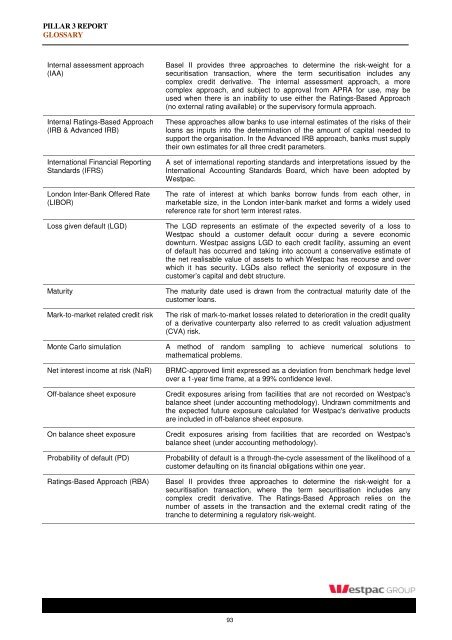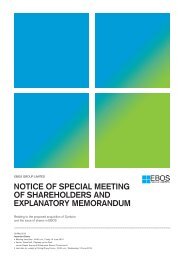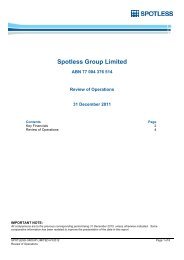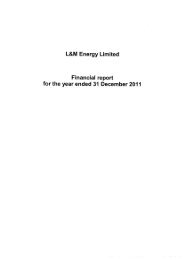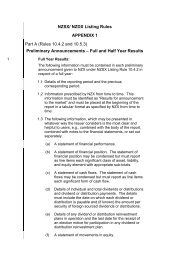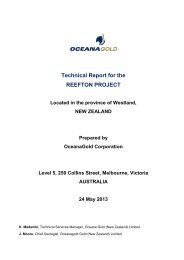Westpac Group Pillar 3 Report March 2013 - Iguana IR Sites
Westpac Group Pillar 3 Report March 2013 - Iguana IR Sites
Westpac Group Pillar 3 Report March 2013 - Iguana IR Sites
You also want an ePaper? Increase the reach of your titles
YUMPU automatically turns print PDFs into web optimized ePapers that Google loves.
PILLAR 3 REPORT<br />
GLOSSARY<br />
Internal assessment approach<br />
(IAA)<br />
Internal Ratings-Based Approach<br />
(<strong>IR</strong>B & Advanced <strong>IR</strong>B)<br />
International Financial <strong>Report</strong>ing<br />
Standards (IFRS)<br />
London Inter-Bank Offered Rate<br />
(LIBOR)<br />
Loss given default (LGD)<br />
Maturity<br />
Mark-to-market related credit risk<br />
Monte Carlo simulation<br />
Net interest income at risk (NaR)<br />
Off-balance sheet exposure<br />
On balance sheet exposure<br />
Probability of default (PD)<br />
Ratings-Based Approach (RBA)<br />
Basel II provides three approaches to determine the risk-weight for a<br />
securitisation transaction, where the term securitisation includes any<br />
complex credit derivative. The internal assessment approach, a more<br />
complex approach, and subject to approval from APRA for use, may be<br />
used when there is an inability to use either the Ratings-Based Approach<br />
(no external rating available) or the supervisory formula approach.<br />
These approaches allow banks to use internal estimates of the risks of their<br />
loans as inputs into the determination of the amount of capital needed to<br />
support the organisation. In the Advanced <strong>IR</strong>B approach, banks must supply<br />
their own estimates for all three credit parameters.<br />
A set of international reporting standards and interpretations issued by the<br />
International Accounting Standards Board, which have been adopted by<br />
<strong>Westpac</strong>.<br />
The rate of interest at which banks borrow funds from each other, in<br />
marketable size, in the London inter-bank market and forms a widely used<br />
reference rate for short term interest rates.<br />
The LGD represents an estimate of the expected severity of a loss to<br />
<strong>Westpac</strong> should a customer default occur during a severe economic<br />
downturn. <strong>Westpac</strong> assigns LGD to each credit facility, assuming an event<br />
of default has occurred and taking into account a conservative estimate of<br />
the net realisable value of assets to which <strong>Westpac</strong> has recourse and over<br />
which it has security. LGDs also reflect the seniority of exposure in the<br />
customer’s capital and debt structure.<br />
The maturity date used is drawn from the contractual maturity date of the<br />
customer loans.<br />
The risk of mark-to-market losses related to deterioration in the credit quality<br />
of a derivative counterparty also referred to as credit valuation adjustment<br />
(CVA) risk.<br />
A method of random sampling to achieve numerical solutions to<br />
mathematical problems.<br />
BRMC-approved limit expressed as a deviation from benchmark hedge level<br />
over a 1-year time frame, at a 99% confidence level.<br />
Credit exposures arising from facilities that are not recorded on <strong>Westpac</strong>'s<br />
balance sheet (under accounting methodology). Undrawn commitments and<br />
the expected future exposure calculated for <strong>Westpac</strong>'s derivative products<br />
are included in off-balance sheet exposure.<br />
Credit exposures arising from facilities that are recorded on <strong>Westpac</strong>'s<br />
balance sheet (under accounting methodology).<br />
Probability of default is a through-the-cycle assessment of the likelihood of a<br />
customer defaulting on its financial obligations within one year.<br />
Basel II provides three approaches to determine the risk-weight for a<br />
securitisation transaction, where the term securitisation includes any<br />
complex credit derivative. The Ratings-Based Approach relies on the<br />
number of assets in the transaction and the external credit rating of the<br />
tranche to determining a regulatory risk-weight.<br />
93


